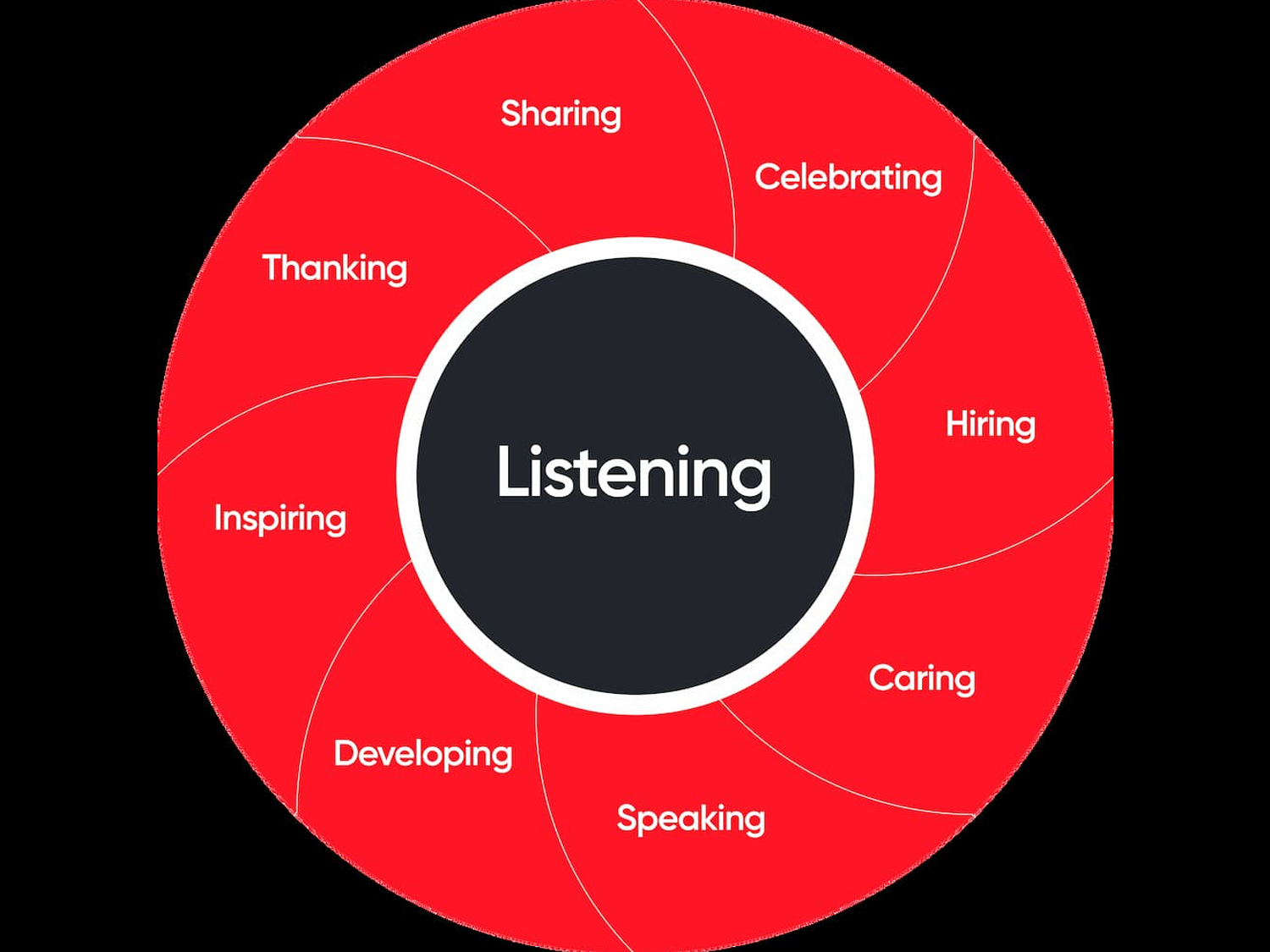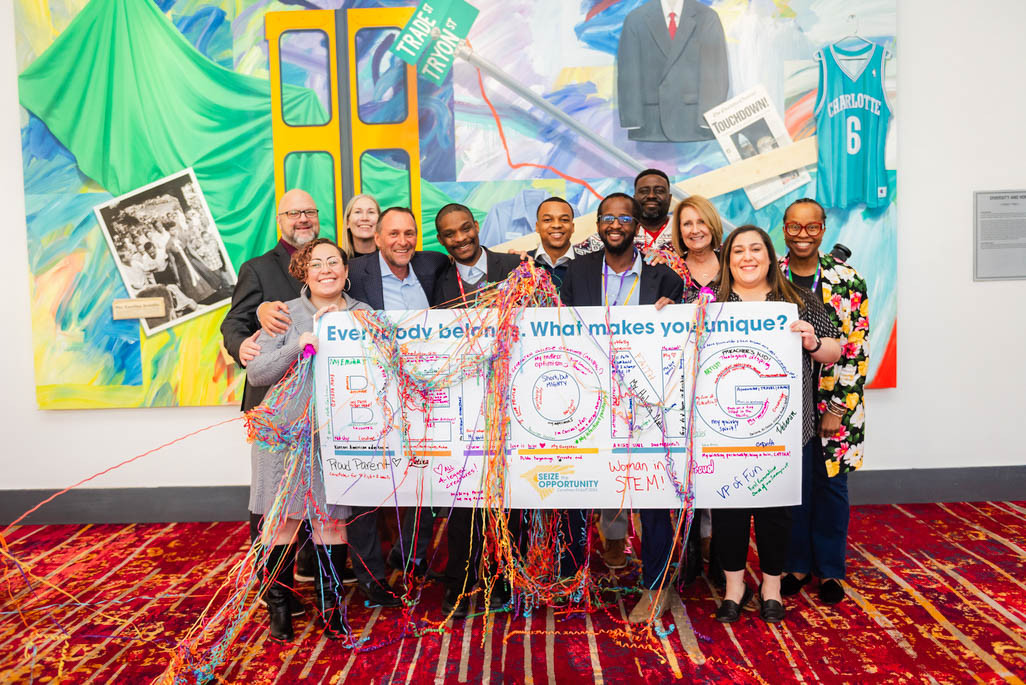Equity, High-trust leadership, Sharing
Beyond fair pay and generous benefits, employees expect to have equal participation and access to all outcomes of a company’s success.
When looking at “sharing” — one of the nine high-trust leadership behaviors that strengthens workplace culture — most leaders focus on pay.
However, just crunching the numbers doesn’t capture an important driver of trust in organizations: employees’ perception of fairness. You might pay everyone the same, and some employees will still feel underpaid for their efforts.
“Equity does not equal sameness,” says Michael C. Bush, CEO of Great Place To Work®. What really matters is ensuring that every employee, regardless of role, feels like they share in a company’s success.
That means clearly communicating about performance, incentive structure, and career opportunities, Bush says. “Make sure you’re truly inclusive in terms of sharing opportunities for people, as well as the resources of the organization.”
The best workplaces also think broadly about what people value as a reward for their work at a company. Financial compensation is one example, but employees also value the ability to give back to their community and opportunities for development and career advancement.
If your company rewards employees with a year-end holiday bash to celebrate a successful year, how do you ensure all employees can attend?
How leaders can improve
Here’s how companies on the Fortune 100 Best Companies to Work For® List are building cultures that prioritize fairness and build trust:
1. Start with fair pay
Great workplaces carefully review their salary ranges, bonus plans, and total compensation programs to ensure pay is fair, and revisit their analysis regularly.
At NuStar Energy, every employee receives an annual bonus, regardless of what role they play at the company. If the CEO gets a bonus, everyone at the company is getting a bonus.
The company also boasts an unusually low CEO-to-worker pay ratio of 50 to 1, meaning that the CEO only earns 50 times the average annual salary of other employees. The gap is dramatically smaller than the average for the S&P 500, where CEOs typically earn 272 times more than workers at their company.
Great workplaces also consider employee feedback on compensation. When employees can voice concerns, they have more confidence in the compensation process and are more likely to trust that leaders consider their needs when making decisions about pay.
At Ryan LLC, a plan to adjust compensation for remote team members based on their geographic location rankled some team members, who argued the proposal created disparities within a team’s compensation bans.
Ryan leaders listened, and six months after rolling out a plan for remote worker compensation, made adjustments. Compensation is now based on the geographic region for a team’s assigned office location, rather than an individual worker’s location, ensuring fair compensation for work by members of the same team.
Great workplaces also analyze compensation across gender, racial background, job type, and more — and make adjustments when necessary. Salesforce conducts an equal pay analysis every year as part of its annual compensation process. After groups employees into comparable job groups, they analyze compensation to see if there are unexplained gaps based on gender or race. The company also analyzes stock grants to see where disparities might exist.
2. Invest in financial well-being resources
Great workplaces think about how compensation and benefits build a solid foundation for employees to build their lives and care for their families. By taking time to understand the demands on employees’ personal lives, whether that’s inflation, the rising cost of a mortgage, student loan debt, or other costs, companies can tailor resources to address the specific needs of employees.
At Marriott International, leaders saw that offering an employee stock purchase program offered frontline employees a unique opportunity to save for retirement and build wealth. The hotel chain also increased its 401(k) match and saw 85% of eligible associates contributing to those accounts.
Marriott also offers webinars and resources to help associates learn about budgeting, retirement planning, and other ways to protect their finances.
3. Train people leaders to talk about pay and performance
When companies embrace pay transparency, they must ensure that people leaders in their organization are empowered and supported to discuss sensitive issues like performance and pay.
Before rolling out pay transparency and making it possible for team members to see their salary ranges, Ryan’s “Talent Effectiveness” team rolled out a series of training sessions to prepare leaders. Ryan’s compensation process had previously been a black box, and now team members need to understand the company’s compensation philosophy.
Team members received training about how pay ranges were determined, and managers learned how to articulate what individual employees needed to accomplish to move up in their pay range or into a different role.
The Talent Effectiveness team took the extra step of revamping the performance management process, moving from a rating scale of one through five to a competency-based model that outlined specific skills and abilities needed to advance through the organization.
The result was increased clarity around expectations for team members, a better toolbox for leaders to help their employees develop, and more visibility throughout the organization for employees that were overperforming in their roles.
Great workplaces also encourage their people leaders to have more frequent, ongoing conversation about performance.
At Synchrony, employees and managers receive training on how to set goals. Employees learn how to define goals that are relevant for their role and contribute to career growth. Managers learn how to embed conversations around goals into the review process and provide continuous coaching to those who report them.
4. Ensure every employee has an opportunity to develop, grow, and advance
Pay and benefits are just some of the rewards employees look for when considering a job. Opportunities to learn or build a career are extremely valuable, and great workplaces go the extra mile to help every employee have an opportunity to grow.
DHL Express uses a career marketplace, powered by artificial intelligence, to match employees with learning opportunities within the company. Inspired by LinkedIn, the platform suggests open positions aligned with the career goals employees add to their profile.
Hilton and Cadence have invested heavily in mentorship tools to pair employees with mentors inside the organization. Hilton also provides employes with virtual coaching via BetterHelp.
Great workplaces make sure that every employee, regardless of role, can develop their career. At Walmart, 75% of salaried managers in U.S. stores, clubs, and supply chain facilities started in hourly roles. The company also offers frontline workers the opportunity to train with its “Associate to Driver” program, which helps them to earn a commercial driver’s license and a position as a truck driver for the retailer, which can pay up to $110,000 in their first year on the job.
5. Be transparent so every employee can have the information needed to be a strategic partner
How is information shared throughout the organization? Do frontline employees feel like they have the knowledge to participate as a full participant in the business?
Hilcorp Energy Company stands out in how much transparency it offers employees about the inner workings of the business.
“We give every employee access to the company’s financials, share our measures of business success, and we teach them how to understand them,” says Mike Brezina, senior vice president, human resources at Hilcorp. “We open the books and share our financial measures such as cash flow, margin, production rate, lifting costs, investments, oil and gas price impacts, storage costs, and more.”
Hilcorp is particularly proud of its flat organizational structure, embodied by its “five-layer strategy” that limits the number of managerial levels between an individual contributor and the CEO of the company. What makes the biggest difference is the trust that Hilcorp leaders show to their workforce, trusting their team members to act like owners of the business.
“Whether through identifying projects, developing a budget, or setting goals, the decisions and actions of each teams’ plans starts from the bottom-up,” Brezina says. “Decisions are then rolled up into the company-wide annual goals that are shared at every lifting cost meeting.”
6. Consider other perks that employees value as part of their employment
Work offers more rewards than just money. Many employees value how working for a great company enables them to be involved and give back to their community.
Great workplaces are thinking about how to make sure that these ancillary benefits are also equitably shared across their workforce.
At Cisco, every year since 2020 has seen more than 80% of employees participate in volunteering and charitable giving. To achieve this remarkable result, Cisco points to a few strategies:
- It provides new hires with donation credits upon joining the organization, ensuring they can immediately engage and build the habit of giving back.
- It launched a platform called “The Community Impact Portal,” which easily connects employees with opportunities to volunteer and give, and tracks participation across the organization.
Great workplaces are always asking about which group of employees might be left behind, or how to increase full participation in the benefits of being associated with the company. When employees feel like they are respected as an equal and valuable member of the team, they give more effort, and are more likely to stay in their role.
Join us in Las Vegas!
Register for the next For All Summit™, April 8-10, to connect with leaders and experts from great workplaces around the world.











